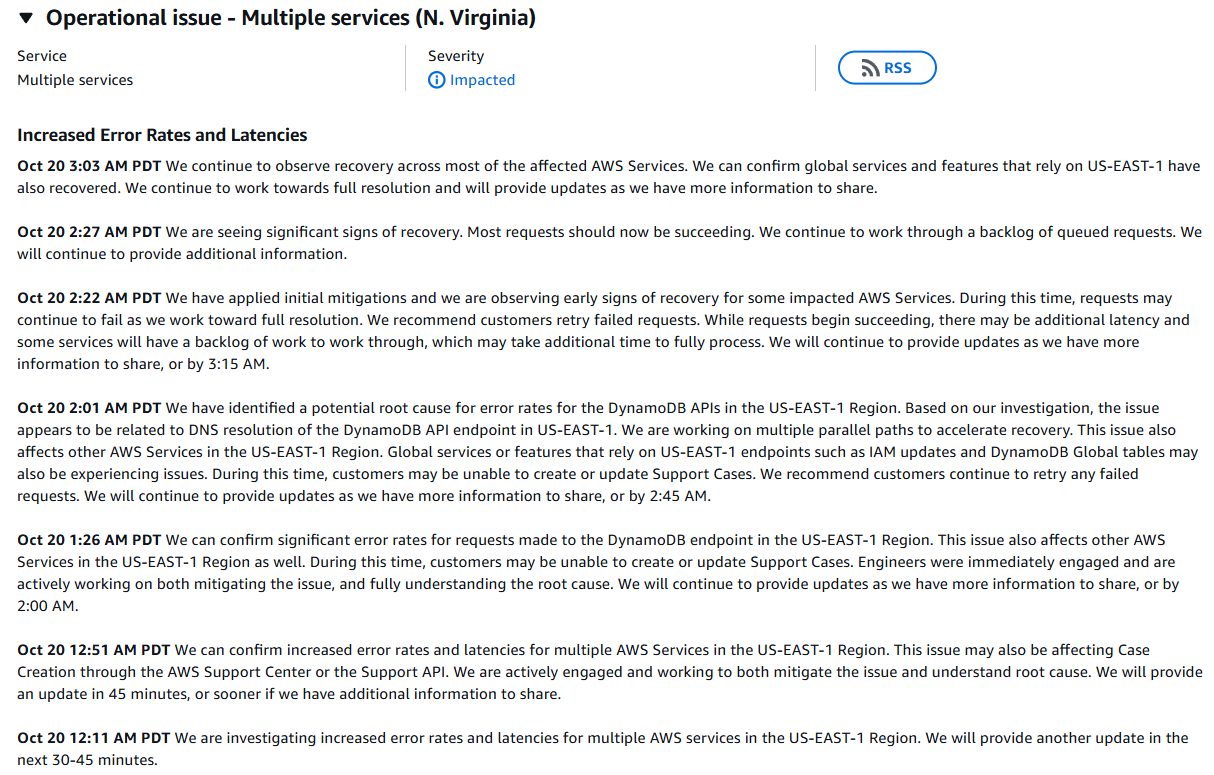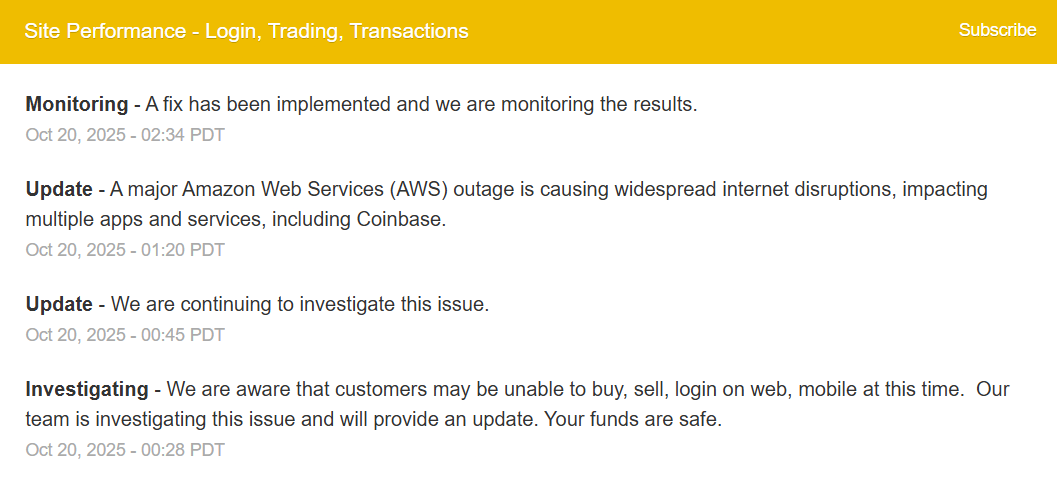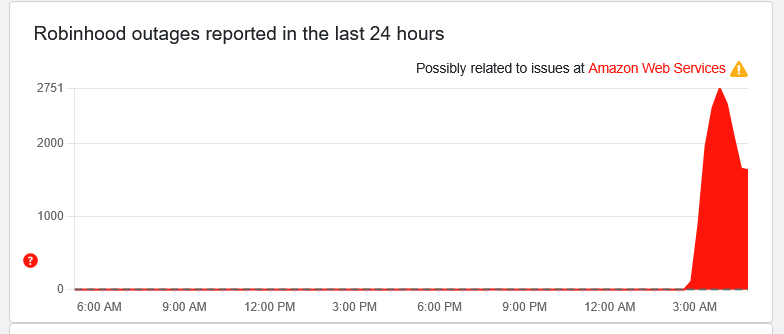The recent AWS outage in Northern Virginia disrupted Coinbase services, causing login failures, trading delays, and withdrawal issues for users. This second major incident in 2025 highlights the vulnerabilities of centralized cloud providers in supporting critical cryptocurrency infrastructure, affecting platforms like Coinbase and Robinhood.
-
AWS US-EAST-1 region experienced increased error rates and latencies, impacting multiple services.
-
Coinbase’s mobile app crashed, preventing users from accessing accounts and executing trades.
-
Over 12 AWS services were affected, with recovery taking about three hours; statistics show similar outages hit eight crypto exchanges earlier this year.
AWS outage Coinbase: Explore the impact of Amazon’s cloud disruption on crypto trading platforms like Coinbase. Uncover risks and solutions for resilient infrastructure. Read now for key insights on decentralization in 2025.
What is the Impact of the AWS Outage on Coinbase?
The AWS outage Coinbase incident stemmed from connectivity problems in Amazon Web Services’ Northern Virginia data center, leading to widespread disruptions across multiple services. This event, reported on Monday, caused Coinbase’s mobile application to crash, affecting user logins, order placements, and fund withdrawals globally. Recovery efforts restored most functions within hours, but it exposed ongoing risks for cryptocurrency exchanges reliant on centralized cloud systems.

This marks the second significant AWS disruption in 2025, following an April event that created usability issues for at least eight major cryptocurrency exchanges. Coinbase, as the third-largest centralized exchange by trading volume, confirmed the outage led to “increased error rates and latencies” in services dependent on the US-EAST-1 region. Users reported frustration with the Base app also facing interruptions during peak trading hours.
AWS issued an update approximately three hours after the initial report, stating that global services relying on the affected region had recovered, though full resolution efforts continued. Coinbase echoed this in their status update, noting early signs of recovery and prioritizing the fix to minimize further impact on traders.

How Did the AWS Outage Affect Other Platforms Like Robinhood?
While the primary focus was on crypto platforms, the outage extended to stock trading services, with Robinhood users experiencing execution delays and API malfunctions. Reports from traders highlighted issues across non-crypto sectors, including Reddit, McDonald’s applications, and even gaming platforms like Fortnite. A crypto trader known as Kushy noted on social media, “Amazon down, Robinhood down, Reddit down, McDonald’s down, Fortnite down,” illustrating the broad ripple effects of the single data center failure.

Data from AWS indicates that at least 12 services were compromised, with connectivity issues cited as the root cause, similar to the April incident. That earlier outage affected eight crypto exchanges, including major players, and underscored how a single point of failure can halt billions in daily trading volume. Official statistics from AWS health dashboards show that such events, though rare, occur due to network bottlenecks in high-demand regions like US-EAST-1, which handles a significant portion of global internet traffic.
Experts emphasize that these disruptions highlight the fragility of centralized infrastructure. As one industry analyst from a financial research firm stated, “Reliance on providers like AWS, while efficient for scalability, introduces systemic risks that the crypto sector, built on decentralization principles, should actively mitigate.” This perspective is supported by data showing that cloud outages cost businesses an average of $9,000 per minute in lost revenue, with crypto platforms facing amplified losses due to volatile markets.
Frequently Asked Questions
What Major Crypto Exchanges Rely on AWS Infrastructure?
Several leading centralized exchanges, including Binance, Coinbase, BitMEX, Huobi, Crypto.com, and Kraken, utilize AWS for their cloud computing needs. This setup supports high-volume trading with low latency but exposes them to outages like the recent one in Northern Virginia. According to AWS documentation, these platforms benefit from scalable services, yet diversification is recommended to avoid single-provider dependencies, as evidenced by the April 2025 incident affecting eight such exchanges.
How Can Crypto Platforms Prepare for Future AWS Outages?
Crypto platforms can enhance resilience by adopting multi-cloud strategies or decentralized alternatives to reduce reliance on a single provider like AWS. Implementing redundant systems across regions and regular backup protocols ensures quicker recovery from disruptions. For instance, during the Monday outage, platforms with diversified infrastructure experienced minimal downtime, allowing seamless trading continuity even as others faced hours of delays— a practical step for maintaining user trust in volatile markets.
Key Takeaways
- AWS Outage Vulnerability: The Northern Virginia incident disrupted Coinbase and Robinhood, causing trading halts and emphasizing the need for robust contingency plans in crypto infrastructure.
- Second Major Event in 2025: Following April’s connectivity issues that hit eight exchanges, this outage affected over 12 AWS services, costing platforms significant operational time and user confidence.
- Push for Decentralization: Projects like Vanar Chain’s Neutron layer and the Internet Computer protocol offer on-chain storage and computing, enabling crypto firms to eliminate third-party risks and achieve true resilience.
Conclusion
The AWS outage Coinbase event serves as a stark reminder of the risks inherent in centralized cloud dependencies for the cryptocurrency ecosystem, particularly for exchanges handling substantial trading volumes. With secondary impacts on platforms like Robinhood and broader services, it reinforces the urgency for adopting decentralized infrastructure solutions such as blockchain-based clouds from providers like Filecoin, Akash Network, and Render Network. As the industry evolves, prioritizing these alternatives will safeguard against future disruptions, ensuring stable operations and fostering innovation in the years ahead. For the latest updates on crypto infrastructure trends, follow COINOTAG’s reporting—published October 2025, last updated post-resolution.
Vanar Chain’s CEO Jawad Ashraf highlighted the potential of such technologies, noting that innovations like AI-native blockchain layers can store and verify data on-chain without external reliance, unlocking new efficiencies for the sector. This outage, while resolved swiftly, prompts exchanges to reassess their setups, potentially accelerating the shift toward Web3-native solutions that align with cryptocurrency’s foundational ethos of decentralization.







